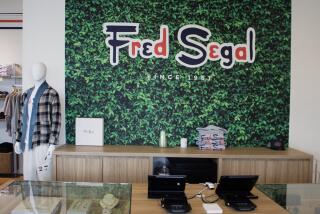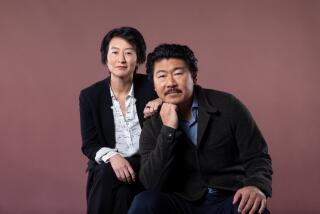Not Small Change : 99 Cents Stores Thrive in Tough Times
One day in 1984, when crowds poured into Los Angeles for the Summer Olympics, David Gold and Thomas Hale made a $185,000 buy that would launch their 99 Cents Only Stores into the mainstream and foreshadow the future of their quirky off-priced outlets.
Gold and Hale, president and vice president of 99 Cents Only Stores, had bought 500,000 authentic Olympic souvenir hats at a special low price--37 cents each--days before the games commenced.
They decided to sell the half million hats for 99 cents apiece when other stores listed them at $8 each. As excitement surrounding the Olympic Games grew, one television station after another broadcast the special on Olympic hats. Gold and Hale, with their three small stores, were overwhelmed.
“All of a sudden, our phone started ringing and didn’t stop for two weeks,” said Hale. “We had to hire security guards to hold people back. Before I could take van loads of the hats into the store, they were sold; they never made it to the counter. I had never seen anything like it in all my years in retailing.”
Since then, Vernon-based 99 Cents Only Stores has burgeoned into a 24-store chain. “Each store we’ve opened . . . has done better than the next,” Hale said.
While other Southern California businesses are feeling the brunt of the weak economy--particularly in their pre-holiday sales--Gold and Hale are finding money-tight consumers flocking to their stores in search of food products and health and beauty supplies that sell for less than a dollar apiece.
At a time when many businesses are being forced to scale back, Gold and Hale plan to open two more 99 Cents Only Stores by spring in Huntington Park and Lawndale. Additional openings are being considered for late 1992, Hale said.
Their strategy, Hale explained, is to buy brand-name products and close-out items from suppliers and sell them at one price--99 cents. According to their advertising, they do this from 9 a.m. to 9 p.m. nine days a week.
“We don’t buy something just because it’s cheap,” Hale said. “We try to buy things that customers recognize and would use. The customer has to walk in and immediately identify a product and say, ‘Wow.’ If we don’t get that reaction, then we don’t get the repeat on the customer.”
The 99 Cents Only Stores, a private company, does not reveal its sales. Analysts said 99 Cents Only Stores and some larger discount retailers--such as Target, owned by Minnesota’s Dayton Hudson Corp., and Arkansas-based Wal-Mart Stores Inc.--have seen slow but steady sales increases in recent years. Money-conscious consumers are more likely to give discount stores a second look when shopping for brand-named merchandise, analysts said.
Companies such as 99 Cents Only Stores survive and sometimes thrive because they “buy opportunistically,” said Robert Kahn, publisher of Retailing Today, a newsletter for senior retail management. “There has always been a problem (for wholesalers) with end-of-season items--what is left over. If you go back to a store like 99 Cents Only six months later, chances are you would not find the same merchandise.”
Gold and Hale, the men behind the 99 Cents Only Stores, appear as varied as their product line. Hale, a silver-haired man with a sonorous voice who dresses in jacket and tie and uses honorifics when referring to clients--and himself--has the stature of a business executive.
Gold, his partner, is a private man with longish hair whom an employee described as “the only CEO who doesn’t want his name in the paper.” Despite their differences, the two have found themselves at the helm of one of Southern California’s fast-growing retailing chains.
Three days a week, the 99 Cents Only Stores chain has open buying for wholesalers and suppliers at the company’s Vernon headquarters. In a small room with signs reading: “WE LOVE SALES PEOPLE” and “THANK YOU FOR COMING” one recent morning, Gold relaxed with sales people, snacking on bagels.
In 25 minutes, Gold purchased four truckloads of sardines, a truckload of pinto beans and hundreds of boxes of Pillsbury chocolate cake mix, turning down offers only on canvas belts, a suitcase full of hair ribbons and a truckload of vanilla soda.
The 99 Cents Only Store began in 1982 when Gold, who had worked as a wholesaler, decided to branch out into retailing. The concept behind the first store near Inglewood was to sell close-out and discontinued items and name-brand products with label changes for 99 cents each. If he could supply customers with a large selection of products, his business would find its niche in the competitive retailing market of Southern California, Hale said.
Over the next two years, as customer response grew, mainly by word of mouth, Gold bought out two five-and-dime stores and thus became a small local chain.
Realizing the possibility for further growth, Gold teamed up with Hale, who had worked in retailing. In 1984, they bought seven leases from Jewel T, a grocery chain that was closing its 21 stores in Southern California, and most of the Chicago-based company’s inventory.
When they saw the crowds they had drawn to their stores during the 1984 Olympics, their confidence in retailing grew and they searched for other low-end merchandise they could offer at 99 cents that would attract customers.
But along with success, Gold and Hale have felt a backlash from the state and several communities for merchandise they have sold at their stores. Their company has also had to do battle with copycat competitors.
The 99 Cents Only Stores went up against the state in 1987, after it lost its bid to reinstate lottery sales for 99 cents on $1 lottery tickets. Gold and Hale sued the state lottery in Los Angeles County Superior Court but lost when lottery officials argued successfully that a voter-approved initiative prevented ticket discounts without the lottery commission’s approval.
But a few communities and local churches have been only marginally successful protesting 99 Cents Only Stores’ sales of beer and wine. The groups had argued that the sale of alcoholic beverages would interfere with church services and activities and would increase litter in areas of the city.
The chain now has alcohol licenses for 17 of its 24 stores, offering one or two brands of unrefrigerated beer and wine.
This year, 99 Cents Only Stores won two cases against Tiger 99 Cent Store and Nothing Over $1 Inc., two Southern California discount stores. The court prevented the two stores from using “99,” “99” and “any other confusingly similar numbers, words or phrases” because 99 Cents Only Stores has registered its name with the state. The 1991 cases are a fraction of an estimated 165 lawsuits the chain has filed in similar instances.
When the first 99 Cents Only Store opened, Hale said, there was uncertainty about whether it could sell enough products at 99 cents to survive. In less than a decade, it has seen customers fill their shopping baskets with 99-cent specials in their two dozen stores and suppliers show up three days a week to resupply their inventory. Gold and Hale have found their niche in Southern California.
With rising manufacturing costs and salaries to pay middle management, the only uncertainty is whether one day 99 Cents Only Stores may need a name change.
“There’s always that possibility,” Hale said. “At some point we may have to consider raising our price--to $1.99.”
Filling Shelves Without Frills
BUYING: The Los Angeles chain mainly buys its products in three ways. * Close-out merchandise is bought from retailers that have either gone out of business or want to remove items that do not sell well at their stores. * Manufacturers offer the stores a special price on large quantities of popular items to stir up the market or sell products in large volume that are not big sellers. * Open-buying days held three days a week at the company’s Vernon headquarters. Wholesalers and sales people meet with the company president to sell their items.
STORAGE: 99 Cents Only Stores keep their merchandise in three large warehouses at company headquarters. The company then decides the price on items based on the cost it paid and the quantity purchased. The chain has stores only in the Los Angeles area, so shipment cost is lower than many national retailers.
STOCKING SHELVES: Merchandise is then shipped to its stores throughout the Los Angeles area. Generally, products are sold within a few weeks, but stock is not rotated and will sit on the shelves until its sold unless it is a food product with an expirition date. The stores use displays for new or seasonal products.
99 Cents Only Stores At a Glance
President: David Gold
Founded: First store at 6854 La Tijera Blvd. opened in August, 1982
Number of stores: 24
New openings: Stores slated for Lawndale by Dec. 1 and Huntington Park by February, 1992
Estimated number of employees: 700
Store philosophy: “We don’t buy something just because it’s cheap,” says Vice President Thomas Hale. “We try to buy things that customers recognize and would use. The customer has to walk in and immediately identify a product and say, ‘Wow.’ If we don’t get that reaction, then we don’t get the repeat on the customer.”
Pricing strategy: Items are sold for either 99 cents a piece, or multiple items in 99-cent packages. They sell no products for more or less than 99 cents.
More to Read
Go beyond the scoreboard
Get the latest on L.A.'s teams in the daily Sports Report newsletter.
You may occasionally receive promotional content from the Los Angeles Times.









